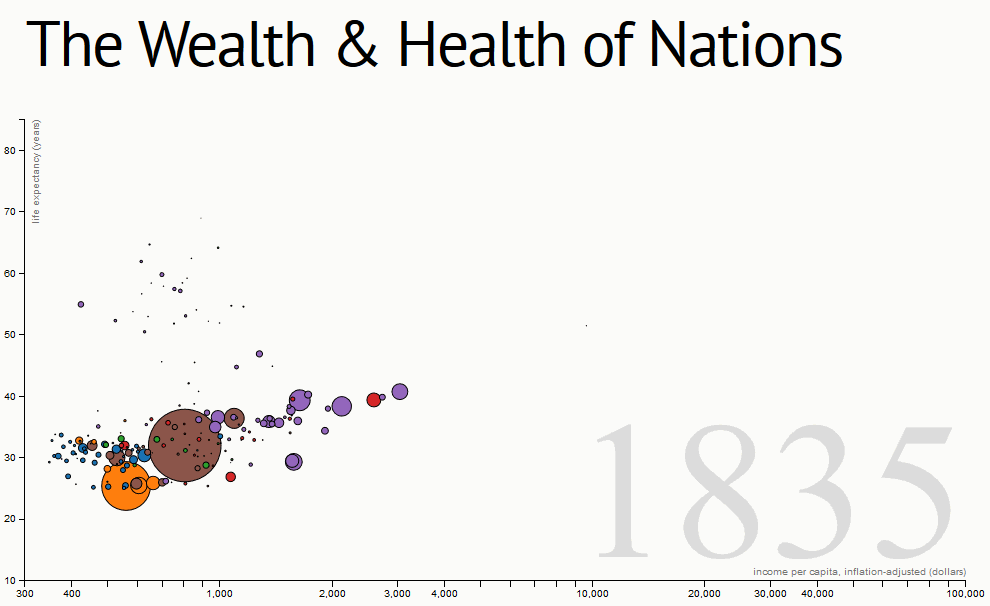J'essaie de reproduire le tableau des nations de la santé et de la richesse.
http://bost.ocks.org/mike/nations/:

Lorsque je clique sur le démarrage de l'animation du graphique, ce qui fonctionne parfaitement et si je clique, arrêtez l'animation, s'arrête. Cependant, si je clique sur le démarrage la prochaine fois, il commence à la place du début de l'endroit où je me suis arrêté? Comment puis-je animer de l'endroit où je suis parti?
Voici le code:
<h1>The Wealth & Health of Nations</h1>
<p id="chart"></p>
<input type="submit" value="Start" onclick=start();>
<input type="submit" value="Stop" onclick=stop();>
<script src="http://d3js.org/d3.v2.js?2.8.1"></script>
<script>
// Various accessors that specify the four dimensions of data to visualize.
function x(d) { return d.income; }
function y(d) { return d.lifeExpectancy; }
function radius(d) { return d.population; }
function color(d) { return d.region; }
function key(d) { return d.name; }
// Chart dimensions.
var margin = {top: 29.5, right: 29.5, bottom: 29.5, left: 59.5},
width = 960 - margin.right,
height = 500 - margin.top - margin.bottom;
// Various scales. These domains make assumptions of data, naturally.
var xScale = d3.scale.log().domain([300, 1e5]).range([0, width]),
yScale = d3.scale.linear().domain([10, 85]).range([height, 0]),
radiusScale = d3.scale.sqrt().domain([0, 5e8]).range([0, 40]),
colorScale = d3.scale.category10();
// The x & y axes.
var xAxis = d3.svg.axis().orient("bottom").scale(xScale).ticks(12, d3.format(",d")),
yAxis = d3.svg.axis().scale(yScale).orient("left");
// Create the SVG container and set the origin.
var svg = d3.select("#chart").append("svg")
.attr("width", width + margin.left + margin.right)
.attr("height", height + margin.top + margin.bottom)
.append("g")
.attr("transform", "translate(" + margin.left + "," + margin.top + ")");
// Add the x-axis.
svg.append("g")
.attr("class", "x axis")
.attr("transform", "translate(0," + height + ")")
.call(xAxis);
// Add the y-axis.
svg.append("g")
.attr("class", "y axis")
.call(yAxis);
// Add an x-axis label.
svg.append("text")
.attr("class", "x label")
.attr("text-anchor", "end")
.attr("x", width)
.attr("y", height - 6)
.text("income per capita, inflation-adjusted (dollars)");
// Add a y-axis label.
svg.append("text")
.attr("class", "y label")
.attr("text-anchor", "end")
.attr("y", 6)
.attr("dy", ".75em")
.attr("transform", "rotate(-90)")
.text("life expectancy (years)");
// Add the year label; the value is set on transition.
var label = svg.append("text")
.attr("class", "year label")
.attr("text-anchor", "end")
.attr("y", height - 24)
.attr("x", width)
.text(2000);
function start()
{
//alert("Start Clicked");
// Load the data.
d3.json("nations_new.json", function(nations) {
// A bisector since many nation's data is sparsely-defined.
var bisect = d3.bisector(function(d) { return d[0]; });
// Add a dot per nation. Initialize the data at 2000, and set the colors.
var dot = svg.append("g")
.attr("class", "dots")
.selectAll(".dot")
.data(interpolateData(2000))
.enter().append("circle")
.attr("class", "dot")
.style("fill", function(d) { return colorScale(color(d)); })
.call(position)
.sort(order);
// Add a title.
dot.append("title")
.text(function(d) { return d.name; });
// Add an overlay for the year label.
var box = label.node().getBBox();
var overlay = svg.append("rect")
.attr("class", "overlay")
.attr("x", box.x)
.attr("y", box.y)
.attr("width", box.width)
.attr("height", box.height);
//.on("mouseover", enableInteraction);
// Start a transition that interpolates the data based on year.
svg.transition()
.duration(30000)
.ease("linear")
.tween("year", tweenYear)
.each("end", enableInteraction);
// Positions the dots based on data.
function position(dot) {
dot .attr("cx", function(d) { return xScale(x(d)); })
.attr("cy", function(d) { return yScale(y(d)); })
.attr("r", function(d) { return radiusScale(radius(d)); });
}
// Defines a sort order so that the smallest dots are drawn on top.
function order(a, b) {
return radius(b) - radius(a);
}
// After the transition finishes, you can mouseover to change the year.
function enableInteraction() {
var yearScale = d3.scale.linear()
.domain([2000, 2009])
.range([box.x + 10, box.x + box.width - 10])
.clamp(true);
// Cancel the current transition, if any.
svg.transition().duration(0);
overlay
.on("mouseover", mouseover)
.on("mouseout", mouseout)
.on("mousemove", mousemove)
.on("touchmove", mousemove);
function mouseover() {
label.classed("active", true);
}
function mouseout() {
label.classed("active", false);
}
function mousemove() {
displayYear(yearScale.invert(d3.mouse(this)[0]));
}
}
// Tweens the entire chart by first tweening the year, and then the data.
// For the interpolated data, the dots and label are redrawn.
function tweenYear() {
var year = d3.interpolateNumber(2000, 2009);
return function(t) { displayYear(year(t)); };
}
// Updates the display to show the specified year.
function displayYear(year) {
dot.data(interpolateData(year), key).call(position).sort(order);
label.text(Math.round(year));
}
// Interpolates the dataset for the given (fractional) year.
function interpolateData(year) {
return nations.map(function(d) {
return {
name: d.name,
region: d.region,
income: interpolateValues(d.income, year),
population: interpolateValues(d.population, year),
lifeExpectancy: interpolateValues(d.lifeExpectancy, year)
};
});
}
// Finds (and possibly interpolates) the value for the specified year.
function interpolateValues(values, year) {
var i = bisect.left(values, year, 0, values.length - 1),
a = values[i];
if (i > 0) {
var b = values[i - 1],
t = (year - a[0]) / (b[0] - a[0]);
return a[1] * (1 - t) + b[1] * t;
}
return a[1];
}
});
}
function stop()
{
//alert("stop Clicked");
svg.transition().duration(0);
}
Le fichier JSON est:
[
{
"name":"Angola",
"region":"Sub-Saharan Africa",
"income":[[2000,2446.65],[2001,2479.69],[2002,2773.29],[2003,2785.39],[2004,3007.11],[2005,3533],[2006,4069.56],[2007,4755.46],[2008,5228.74],[2009,5055.59]],
"population":[[2000,10442812],[2001,10623424],[2002,10866106],[2003,11186202],[2004,11521432],[2005,11827315],[2006,12127071],[2007,12420476],[2008,12707546]],
"lifeExpectancy":[[2000,43.56],[2001,43.86],[2002,44.22],[2003,44.61],[2004,45.05],[2005,45.52],[2006,46.02],[2007,46.54],[2008,47.06],[2009,47.58]]
},
{
"name":"china",
"region":"East Asia & Pacific",
"income":[[2000,12446.65],[2001,12479.69],[2002,12773.29],[2003,12785.39],[2004,12007.11],[2005,12533],[2006,12069.56],[2007,12755.46],[2008,12228.74],[2009,12055.59]],
"population":[[2000,31542812],[2001,31623424],[2002,31866106],[2003,32186202],[2004,31521432],[2005,31827315],[2006,32127071],[2007,32420476],[2008,32707546]],
"lifeExpectancy":[[2000,53.56],[2001,63.86],[2002,64.22],[2003,64.61],[2004,76.05],[2005,66.52],[2006,86.02],[2007,87.54],[2008,89.06],[2009,68.58]]
},
{
"name":"India",
"region":"South Asia",
"income":[[2000,22446.65],[2001,22479.69],[2002,22773.29],[2003,22785.39],[2004,22007.11],[2005,22533],[2006,22069.56],[2007,22755.46],[2008,22228.74],[2009,22055.59]],
"population":[[2000,41542812],[2001,41623424],[2002,41866106],[2003,42186202],[2004,41521432],[2005,41827315],[2006,42127071],[2007,42420476],[2008,42707546],[2009,42707546]],
"lifeExpectancy":[[2000,43.56],[2001,43.86],[2002,44.22],[2003,64.61],[2004,56.05],[2005,56.52],[2006,66.02],[2007,68.54],[2008,67.06],[2009,73.58]]
}
]
